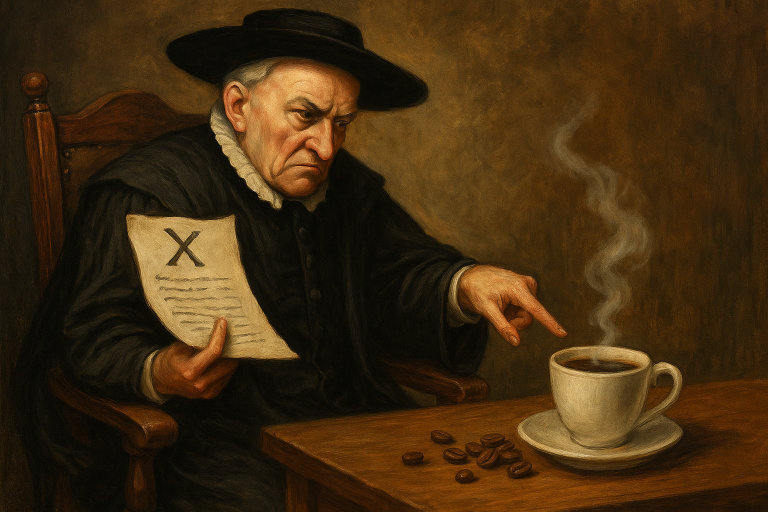
Coffee is more than just a daily ritual — it’s a global phenomenon with a rich and mysterious past. The story of coffee spans centuries, continents, and cultures, from ancient Ethiopian highlands to bustling coffee shops across the world.
Let’s travel through time and uncover how coffee went from a humble forest plant to the most beloved beverage on the planet.
The most popular origin story of coffee begins in Ethiopia, around the 9th century. According to legend, a goat herder named Kaldi noticed his goats becoming unusually energetic after eating red cherries from a certain tree.
Curious, Kaldi tried the berries himself and felt a sudden burst of energy. He shared his discovery with a local monk, who used the berries to create a drink that helped him stay awake during long prayers.
From there, the energizing berries spread among religious communities. While we can’t confirm the legend, Ethiopia is indeed the birthplace of Arabica coffee, and wild coffee still grows naturally in its forests today.
By the 15th century, coffee had made its way across the Red Sea to Yemen, where Sufi monks used it to stay alert during night prayers. Yemeni traders were the first to cultivate and intentionally process coffee as a beverage.
The port city of Mocha became a key hub, giving rise to the famous “Mocha coffee”. From Yemen, coffee spread quickly to:
The drink became so widespread that it was referred to as “the wine of Islam”, praised for its ability to stimulate without intoxicating.
In the 16th century, coffee began transforming public life. The first coffeehouses, or qahveh khaneh, appeared in major Islamic cities like:
These establishments were not just places to drink — they became centers of intellectual exchange, where people discussed politics, poetry, music, and philosophy.
Coffeehouses gained a reputation as “schools of the wise.” This cultural revolution sparked concern among authorities, leading to multiple bans and controversies over coffee throughout history.
Coffee reached Europe in the 17th century through trade with the Ottoman Empire and merchants from Venice and other ports.
At first, Europeans were suspicious of this “bitter Muslim beverage,” even calling it the “Devil’s drink.” But in 1600, Pope Clement VIII tasted coffee and declared it so delicious that he gave it his blessing.
Soon, coffeehouses sprang up across Europe:
These cafés became important meeting places for artists, scientists, merchants, and revolutionaries alike.
As demand for coffee grew, European powers saw an opportunity — and began planting coffee in their colonies.
This led to the global spread of coffee cultivation, but also connected coffee to colonialism, slavery, and exploitation, particularly in Latin America and Africa.
By the 18th and 19th centuries, coffee had become a true global commodity. Innovations such as:
…allowed coffee to be traded, roasted, and consumed on a massive scale.
Meanwhile, café culture blossomed in cities like Paris, Vienna, and London, where thinkers and writers gathered to exchange ideas. In the United States, coffee consumption skyrocketed during and after the Civil War.
In the 20th century, coffee became even more accessible:
However, the emphasis shifted toward quantity over quality, and many coffees lost their original character in the mass production process.
In the early 2000s, the “Third Wave Coffee Movement” emerged — a reaction to generic coffee culture. This movement emphasized:
It brought coffee back to its roots as a craft and agricultural product, not just a convenience item. Baristas became skilled professionals, and cafés turned into specialty laboratories.
Today, coffee continues to evolve with trends like:
From wild Ethiopian forests to the corners of your favorite café, coffee has been part of spiritual rituals, social revolutions, and global trade routes. It’s more than a beverage — it’s a cultural thread that connects people across time and geography.
Every sip you take carries the story of centuries of discovery, struggle, and innovation. And the best part? The story is still brewing.

Gabriel Rodrigues é especialista em finanças pessoais e escritor, com ampla experiência em economia, planejamento financeiro e gestão de recursos. Apaixonado por ajudar as pessoas a alcançarem sua saúde financeira, ele explora temas variados, desde investimentos até estratégias de poupança. Quando não está escrevendo, você pode encontrá-lo estudando novas tendências financeiras e oferecendo consultoria para quem busca melhorar sua relação com o dinheiro.